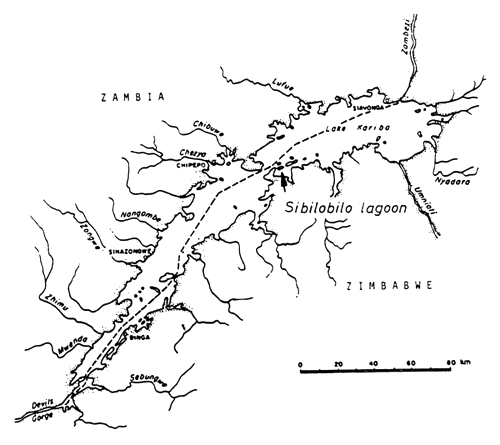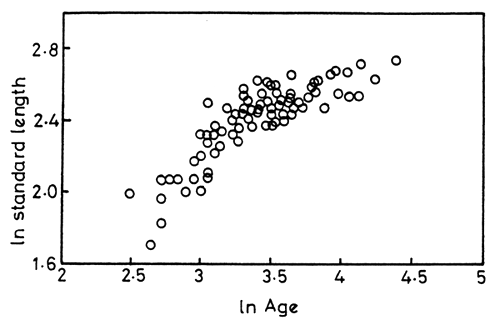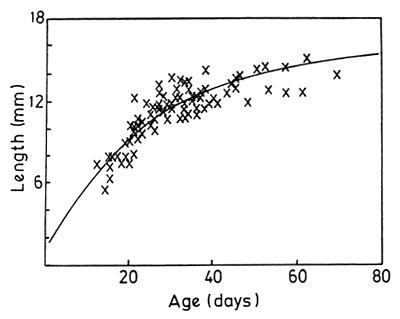by
M.Z. Mtsambiwa
Lake Kariba Fisheries Research Institute
P.O Box 75
Kariba
Zimbabwe
ABSTRACTThe von Bertalanffy growth model was fitted to length-at-age data of larval Limnothrissa miodon from Lake Kariba. These data were obtained by counting the daily growth increments in the otoliths of the larvae. The model was used on the assumption that its linear methods should be replaced by non-linear fitting techniques and that the age estimate obtained from the growth increments is a true nonstochastic independent variable. It should be noted that the asymptotic length used in this model is one that applies to larval, not adult, fish which is usually the case when the von Bertalanffy model is used to describe the growth of fish. RESUMELe modèle de croissance de von Bertalanffy a été adapté aux données concernant la longueur par âge de Limnothrissa miodon larvaire provenant du lac Kariba. Ces données ont été obtenues en dénombrant les fractions journalières de croissance sur les otolithes des larves. L'utilisation de ce modèle repose sur l'hypothèse selon laquelle les méthodes linéaires devraient être remplacées par des techniques d'adaptation non linéaires et que estimé à partir des fractions de croissance sur les otolithes est une variable indépendante non stochastique vraie. II importe de souligner que la longueur asymptotique utilisée dans ce modèle s'applique aux larves et non à des poissons adultes comme c'est généralement le cas lorsqu'on utilise le modèle de von Bertalanffy pour décrire la croissance des poissons. |
The von Bertalanffy growth model is one of the most studied and frequently applied growth models because it is fundamental to the Beverton and Holt yield per recruit equation. It is not without serious shortcomings which include its inability to represent sigmoidal growth in a linear dimension (Gallucci and Quinn, 1979). It has also been used to provide estimates of growth over the entire life cycle of the fish without taking into account the fact that growth rates might vary at different times of life (Pitcher and Hart, 1982). The model is usually based on the fished part of the population, i.e. adults, without due consideration of larval and juvenile stages. This implies that no single model can adequately describe growth in all life stages from the egg to old age but that the von Bertalanffy model has sometimes erroneously been used for this purpose.
In this paper the growth model, modified by Gallucci and Quinn (1979), is applied to larval Limnothrissa miodon from Lake Kariba. This method has been applied to the larvae of another tropical clupeid, Herklostichthyes castelnaui (Tharrold, 1987).
Samples of Limnothrissa larvae were collected in May 1992 in the Sibilobilo Lagoon (Fig. 1) with a plankton net, of 250 μm mesh size, 1.4 m in diameter at its mouth and 4.0 m deep. The net reduced to a cod-end consisting of an enclosure 270 mm long and with a diameter of 150 mm at one end and 55 mm at the other. It was mounted on a boom and pulley system on the Research Vessel Pelican. Lights were used to attract the fish and the net was lowered to the bottom and, after 15 minutes, hauled to the surface with a hydraulic winch.
The fish were measured under a dissecting microscope fitted with an ocular micrometer. Sharp insulin needles were used to remove the otoliths which were then washed in water and dehydrated in 95% alcohol. The otoliths were mounted on slides in clear nail varnish. Daily growth increments were counted under a compound microscope coupled to a black-and-white video camera and a 12-inch black-and-white monitor. A Mackintosh computer was connected to a video coordinate digitiser through the computer's modem port and the digitiser's port. The digitiser makes a vertical black line on the monitor and is controlled by the computer's mouse during the increment counting procedure. Specimens were discarded if their rings were not clearly visible and a total of ninety-nine specimens were examined during this study.
The Gallucci and Quinn (1979) version of the von Bertalanffy model was then used to describe the growth of the larvae. This version of the growth function is fitted by the equation
Lt = ω /k[1 - exp(-k(t - to))]
where Lt = length at time t and k and to = parameters of the von Bertalanffy equation. A new parameter, ω, is introduced; ω = k.L∞ where k and L∞ are von Bertalanffy growth parameters. The parameter ω corresponds to the instantaneous growth rate near to when the fish length is zero. The equation takes the original form of the von Bertalanffy equation when k.L∞ is substituted for ω and the two k values cancel each other. An asymptotic length (L∞) of 15 mm was fixed for the Limnothrissa larvae because Begg (1974) considers this to be the size at which larvae become juveniles.
There was a non-linear relationship, evident even after the data were transformed, between length and age in the samples of Limnothrissa larvae with a distinct upper asymptote (Fig. 2). The following von Bertalanffy growth parameters were obtained; L∞ = 15 mm, k = 0∙04 day-1 and to = -1∙639 and used to fit a growth curve to the data (Fig. 3).
The application of the von Bertalanffy growth function to these samples assumes that some of its shortcomings have been overcome. Firstly, it is fitted to only one life history stage, i.e. larvae. Secondly, the data came from that life history stage and were not extrapolated from another. Finally, the length-at-age values were based on direct estimation by the otolith ageing technique. The discovery of daily rings (Pannella, 1971) has greatly enhanced the accuracy of growth estimates in larval fishes and sometimes provided estimates of growth 2 –3 times faster than those obtained by modal progression in length-frequency distribution (Jones, 1986).
Gallucci and Quinn (1979) emphasise that the form of the growth data must be used to justify the use of the von Bertalanffy model. In this case, there was no linear relationship with either untransformed and transformed length-at-age data. Instead, a non-linear one was found with an asymptote around the size that Begg (1974) suggested was around the maximum for larvae.
These data can be compared with earlier studies, although the appropriateness of comparing values obtained from otolith with those obtained from length-frequency data may be questioned. Cochrane (1984) and Marshall (1987) obtained k values of 0∙145 and 0∙254 month-1 respectively which are considerably lower than that of 1∙21 obtained in this study. The differences might be explained by the fact that adult fish were used in the length-frequency studies whilst larvae fish were used in this one.
I would like to thank my colleagues at the Lake Kariba Fisheries Research Institute for their assistance. This paper is presented with the approval of the Director of the Department of National Parks and Wild Life Management, Zimbabwe.
Begg, G.W., 1974. Investigations into the biology and status of the Tanganyika sardine, Limnothrissa miodon (Boulenger) in Lake Kariba. Lake Kariba Fish. Res. Inst., Proj. Rept 17: 151 pp.
Cochrane, K.L., 1984. The influence of food availability, breeding seasons and growth rate on the commercial catches of Limnothrissa miodon (Boulenger) in Lake Kariba. J. Fish Biol., 24: 623–35.
Gallucci, V.F. and T.J. Quinn, Reparameterizing, fitting and 1979 testing a simple growth model. Trans. Am. Fish. Soc., 108: 14–25.
Jones, C., 1986. Determining age of larval fish with the otolith increment technique. Fish. Bull., U.S., 84: 91–102.
Marshall, B.E., 1987. Growth and mortality of the introduced Lake Tanganyika clupeid, Limnothrissa miodon, in Lake Kariba. J. Fish Biol., 31: 603–15.
Pannella, G., 1971. Fish otoliths: daily growth layers and periodic patterns. Science, 173: 1124–7.
Pitcher, T.J. and P.B. Hart, 1982. Fisheries ecology. London: Croom Helm.
Tharrold, S.R., 1988. Estimating some early life history parameters in a tropical clupeid, Herklostichthyes castelnaui, from daily growth increments in otoliths. Fish. Bull., U.S., 87: 73–83.

Figure 1. Lake Kariba, showing the location of the Sibilobilo Lagoon where Limnothrissa larvae were collected.

Figure 2. The relationship between length and age (estimated from otoliths) in Limnothrissa larvae. Note that the data have been transformed.

Figure 3. The relationship between length and age (estimated from otoliths) in Limnothrissa larvae. The growth curve has been fitted by the von Bertalanffy equation, modified by Gallucci and Quinn (1979).